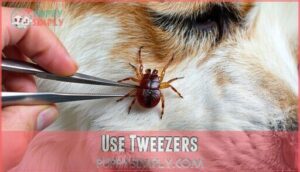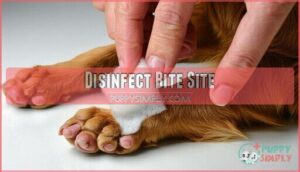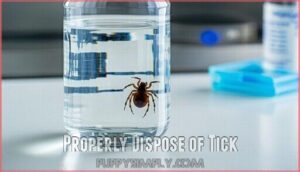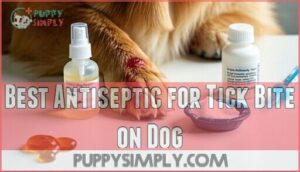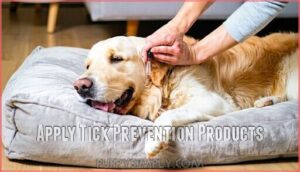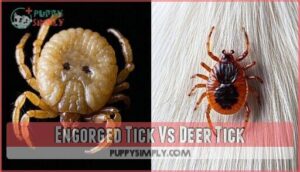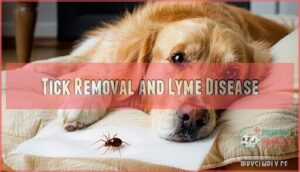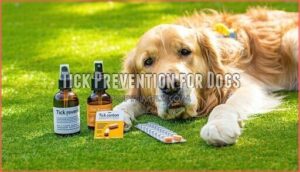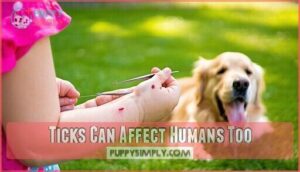This site is supported by our readers. We may earn a commission, at no cost to you, if you purchase through links.
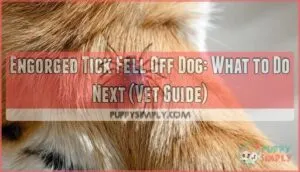 When an engorged tick fell off your dog, don’t panic – this means it’s finished feeding and naturally detached.
When an engorged tick fell off your dog, don’t panic – this means it’s finished feeding and naturally detached.
You’ll want to dispose of it immediately by dropping it in rubbing alcohol or flushing it down the toilet.
Clean your dog’s bite area with antiseptic, then monitor the spot for redness or swelling.
While a fully engorged tick that’s completed its feeding cycle poses less disease risk than one forcibly removed mid-meal, you should still watch for symptoms like lethargy or loss of appetite over the next few weeks.
Knowing the right steps after tick removal can make all the difference.
Table Of Contents
- Key Takeaways
- What to Do When Tick Falls Off Dog?
- What Happens to an Engorged Tick on Dog?
- How to Remove Engorged Tick From Dog?
- Best Antiseptic for Tick Bite on Dog
- After Removing Tick, What’s Next?
- Engorged Tick Vs Deer Tick
- Tick Removal and Lyme Disease
- Tick Prevention for Dogs
- Ticks Can Affect Humans Too
- Frequently Asked Questions (FAQs)
- Do I need to clean my house after finding a tick on my dog?
- Do ticks fall off when they are engorged?
- Is it normal for ticks to fall off dogs?
- What happens when an engorged tick falls off a dog?
- What is the best way to dispose of an engorged tick?
- Is there a way to tell if a tick is engorged?
- Are there any natural remedies for preventing or removing ticks?
- Are there any home remedies for treating tick bites on dogs?
- Are there any signs or symptoms of tick-borne diseases in dogs?
- Can engorged ticks survive after falling off?
- Conclusion
Key Takeaways
- Dispose of the tick immediately – Drop it in rubbing alcohol or flush it down the toilet, since engorged ticks can still transmit diseases even after detaching from your dog.
- Clean and monitor the bite site – Wash the area with antiseptic and watch for redness, swelling, or signs of infection over the next few days to prevent complications.
- Check your entire dog for more ticks – Run your hands through their fur, especially in warm spots like armpits and ears, since finding one tick often means others are present.
- Watch for disease symptoms – Monitor your dog for lethargy, loss of appetite, fever, or joint swelling over the next few weeks, as tick-borne diseases can take time to develop.
What to Do When Tick Falls Off Dog?
When an engorged tick falls off your dog, don’t panic – you’ve caught it at the perfect moment to take action.
When that blood-filled tick drops off your pup, you’re actually ahead of the game – time to take smart action.
First, grab some gloves and carefully pick up the tick.
These blood-filled parasites can still transmit diseases even after tick detachment, so handle with care.
Next, examine the tick bite site closely.
Look for redness, swelling, or any unusual tick bite symptoms that might signal secondary infections developing.
Clean the area gently with soap and water, then apply antiseptic to prevent complications.
Now comes the detective work – conduct a thorough tick identification check on your entire dog.
Run your hands through their fur, paying special attention to warm, hidden spots like armpits, ears, and between toes.
Engorged ticks love these cozy hideouts.
Don’t forget environmental cleanup around your home.
Vacuum carpets, wash your dog’s bedding, and check areas where your pup spends time.
Taking these steps seriously helps prevent re-infestation and keeps your furry friend safe from tick-borne diseases.
What Happens to an Engorged Tick on Dog?
Once an engorged tick detaches from your dog, its fate depends on several factors.
Female ticks will seek a safe spot for egg laying, producing thousands of eggs before dying. Males typically die after mating.
Environmental factors play a vital role in their survival—dry conditions increase desiccation risk, causing death within weeks. However, some species like brown dog ticks can survive longer indoors.
Understanding what happens next helps you take proper action:
- Engorged females drop off to lay 3,000-6,000 eggs in hidden areas
- Males die shortly after mating, usually within days
- Ticks in dry environments gradually lose moisture and die
- Brown dog ticks can survive longer in homes, causing infestations
- Host seeking behavior stops once ticks become fully engorged
The tick’s survival depends on species and environmental conditions. Most engorged ticks won’t survive long without moisture, but some can establish populations in your home.
This makes proper disposal and environmental management essential for preventing future tick problems and reducing tick borne illness risks. As they feed, engorged ticks exhibit noticeable color changes.
How to Remove Engorged Tick From Dog?
You’ll need to act quickly if you find an engorged tick still attached to your dog’s skin.
Use fine-pointed tweezers to grasp the tick close to your dog’s skin, then pull straight outward without twisting to avoid leaving parts behind.
Use Tweezers
Fine-tipped tweezers are your best friend when dealing with embedded ticks on your dog. Choose tweezers with a pointed tip rather than flat ones for better grasping technique.
Position the tweezers at a perpendicular tweezer angle to your dog’s skin, grabbing the tick as close to the skin’s surface as possible. Don’t squeeze the tick’s body – this can push disease-carrying fluids into your pet.
Pull straight up with steady, even pressure. Avoid twisting or jerking motions that might leave the tick’s head behind.
Different tweezer types work, but precision matters most. Consider purchasing specialized tools designed for tick removal.
This safe removal method protects your dog’s health and prevents complications from improper tick removal techniques, ensuring the health and well-being of your pet.
Disinfect Bite Site
Once you’ve safely removed the tick with tweezers, it’s time to clean house on that bite site.
Think of it as giving your pup’s skin a fresh start. Grab some hydrogen peroxide or 70% isopropyl alcohol – these appropriate disinfectants pack the right punch against bacteria.
Gently clean the tick bite site with a cotton ball soaked in your chosen solution. This tick bite disinfection step helps prevent nasty infections from setting up shop.
Watch for infection signs like redness, swelling, or unusual warmth over the next few days. Your dog’s health depends on this simple but important cleaning routine.
Properly Dispose of Tick
Your tick removal job isn’t done until you’ve handled proper tick disposal. Don’t just toss that bloodsucker in the trash where it might crawl back out for round two. These resilient pests can survive longer than you’d expect, so you need to make certain they’re completely eliminated.
Here are the most effective tick disposal methods:
- Drown it in rubbing alcohol – This alcohol tick death method kills ticks quickly and preserves them for vet examination prep if needed
- Freeze the tick – Freezing ticks kills them within days, though it takes longer than alcohol
- Flush it down the toilet – Wrap in tissue first to prevent the tick from clinging to bowl sides
- Seal in a container – Sealing ticks safely in a small jar prevents escape and contamination
To prevent potential harm, it’s vital to regard safe tick disposal. Never crush an engorged tick with your fingers, as this increases disease transmission risk for both you and your dog.
Best Antiseptic for Tick Bite on Dog
Once you’ve successfully removed that stubborn tick, cleaning the bite site becomes your next priority. The right antiseptic can make all the difference in preventing infection and promoting healing.
Antiseptic Ingredients that work best include hydrogen peroxide, rubbing alcohol, and iodine scrub. These proven options effectively kill bacteria around the tick bite area. For gentler care, antiseptic wipes offer convenient cleaning without harsh chemicals.
Veterinary Recommendations often include triple antibiotic ointment like Neosporin applied after initial cleaning. This creates a protective barrier against infection while supporting dog health recovery. Year-round preventative use is essential in regions where ticks are active.
Natural Remedies like diluted tea tree oil provide antibacterial benefits, though you’ll want to mix it with coconut oil first. An antiseptic spray designed for pets offers easy Application Methods without stressing your pup.
Watch for Infection Signs including redness, swelling, or discharge. Proper tick removal followed by appropriate antiseptic care keeps your furry friend comfortable and healthy.
After Removing Tick, What’s Next?
You’ve successfully removed the tick from your dog, but your job isn’t finished yet.
The next steps include applying prevention products, cleaning your home thoroughly, and watching your dog closely for any signs of illness over the coming days.
Apply Tick Prevention Products
After disinfecting the bite site, you’ll want to protect your dog from future tick encounters.
Tick prevention products come in various forms – topical treatments, oral medications, collars, and sprays.
Check product ingredients for your dog’s breed sensitivity, as some breeds react poorly to certain chemicals.
Compare costs and application frequency when choosing between monthly pills or quarterly topicals.
Product effectiveness varies by region and tick species.
Many pet owners find effective tick solutions through online retailers.
Dog ticks require consistent tick control methods, so establish a routine with proven tick repellents for maximum protection.
Effective tick prevention is crucial for your dog’s health, and using the right products can make a significant difference.
Vacuum to Remove Ticks
Your vacuum cleaner becomes your best ally in the battle against tick infestation after discovering an engorged tick on your dog. Vacuum effectiveness depends on thorough coverage of all surfaces where ticks might hide or drop off. Focus on carpets, rugs, upholstery, and pet bedding where these parasites commonly lurk.
Regular environmental vacuuming helps control tick populations before they establish themselves in your home. You’ll want to vacuum at least twice weekly during peak tick season, paying special attention to areas where your dog spends time. A vital tool is a vacuum with HEPA filter for capturing allergens.
- Vacuum types matter – use machines with strong suction and HEPA filters for ideal tick removal
- Target high-risk zones – concentrate on pet sleeping areas, furniture crevices, and carpet edges
- Post-vacuum disposal is crucial – immediately seal vacuum bags or empty canisters into outdoor trash
Consistent vacuum frequency creates an inhospitable environment for dog ticks, supporting your overall tick prevention strategy.
Professional Pest Control
Three types of professional pest control services can tackle your tick problem head-on.
Companies offer customized treatment programs that include thorough property inspections, tick species identification, and targeted elimination strategies.
These experts understand home infestation risks better than anyone, using proven pest control methods like bifenthrin insecticides and habitat modifications around your yard.
Professional treatment costs vary, but many companies provide free quotes and complimentary inspections.
They’ll create long-term solutions by identifying tick hotspots, treating outdoor areas where your dog picked up that engorged tick, and implementing preventative yard care strategies.
Think of it as insurance against future tick bite incidents – because one engorged tick often means more are lurking nearby, waiting to hitch a ride on your unsuspecting pup.
They will help you understand that one engorged tick often indicates a larger issue, and that preventative yard care is essential to avoid future problems.
By taking these steps, you can ensure a safer environment for your pet, and reduce the risk of tick bite incidents.
Monitor Dog’s Health
Vigilance becomes your best friend after tick removal. Watch for behavioral changes like lethargy, limping, or unusual restlessness in your dog. Appetite changes often signal trouble – if your pup suddenly turns their nose up at dinner, take note.
Temperature monitoring helps too; a fever above 103°F warrants immediate attention. Check the bite site daily for redness, swelling, or discharge that could indicate infection.
Tick diseases like Lyme disease can take weeks to show symptoms. Look for tick symptoms including joint swelling, weakness, or difficulty walking. Don’t wait if something seems off – vet consultation is vital when dealing with tickborne diseases.
Early detection makes treatment more effective, so trust your instincts about your dog’s health. It is crucial to identify potential issues early to ensure the best outcome for your dog.
Engorged Tick Vs Deer Tick
Understanding the differences between an engorged tick and deer tick helps you assess your dog’s risk level.
These tick species present unique challenges for pet owners.
Engorgement Differences become obvious when you compare sizes.
An engorged tick appears big, roundish, and wrinkly after feeding, swelling several times its original size.
Deer ticks, scientifically known as Ixodes scapularis, remain consistently small with red-orange bodies and black scutums.
Both types of ticks, like certain dog breeds, may exhibit dominant and guarding instincts that can affect their behavior.
| Feature | Engorged Tick | Deer Tick |
|---|---|---|
| Size | Several times larger when fed | Consistently small |
| Appearance | Round, wrinkled, swollen | Flat, red-orange with black scutum |
| Habitat | Various environments | Wooded, humid areas |
| Disease Transmission | Various pathogens possible | Lyme disease carrier |
Deer Tick Risks pose serious concerns since only this species carries Lyme disease.
Identification Challenges arise because deer ticks have smoother backs than dog ticks, making tick identification tricky.
Regional Prevalence shows deer ticks dominate eastern and Midwest regions, requiring location-specific tick species awareness for your dog’s protection.
Tick Removal and Lyme Disease
Quick tick removal makes all the difference regarding Lyme disease prevention. You’ve got a 24-hour window to remove that bloodsucker before Lyme transmission becomes a real threat.
The bacteria needs time to travel from the tick’s gut to your dog’s bloodstream, so acting fast is your best defense. After tick removal, watch for early symptoms like fever, lethargy, and loss of appetite.
Some dogs develop a telltale bullseye rash around the tick bite area. If you notice these warning signs, don’t wait it out. Contact your vet immediately for diagnostic testing.
Treatment options include antibiotics like doxycycline, which work best when started early. Delaying treatment can lead to serious long-term effects including joint damage and kidney problems.
Your vet might recommend blood tests even if your dog seems fine, especially if you live in an area where tickborne illnesses are common. Remember, prompt action saves your pup from unnecessary suffering.
Tick Prevention for Dogs
Prevention beats treatment every time in the matter of protecting your dog from ticks.
Smart pet parents know that staying ahead of these blood-sucking pests saves both worry and vet bills down the road.
Here are four proven tick prevention methods that’ll keep your pup safe:
- Tick repellent types – Choose from sprays, collars, or topical treatments that create a protective barrier
- Preventative medication – Monthly oral medications provide systemic protection against tick attachment
- Yard tick control – Regular lawn treatments reduce tick populations in your outdoor spaces
- Seasonal tick checks – Perform daily inspections during peak tick season, especially after outdoor adventures
To enhance protection, consider natural tick repellents like eucalyptus oil.
Ticks Can Affect Humans Too
Ticks don’t discriminate—they’ll happily bite humans too.
Human Lyme disease and other tick-borne illnesses affect thousands yearly.
After finding ticks on your dog, check yourself thoroughly.
Human tick removal follows the same rules: use tweezers, grasp near the head, pull straight out.
Watch for tick bite symptoms like bullseye rashes, fever, or fatigue.
Preventing human bites requires vigilance during outdoor activities.
Wear long pants, use repellent, and perform daily tick checks.
Tickborne disease prevention protects your whole family, not just your furry friend, and requires daily tick checks.
Frequently Asked Questions (FAQs)
Do I need to clean my house after finding a tick on my dog?
Yes, you should clean your house after finding a tick on your dog.
Vacuum carpets and floors thoroughly to remove any ticks or eggs that may have fallen off, then dispose of the vacuum bag immediately, which is a critical step to ensure all ticks or eggs are removed.
Do ticks fall off when they are engorged?
After feasting and filling up completely, engorged ticks naturally detach from your dog’s skin.
They’ve gotten their blood meal and will drop off to digest, molt, or lay eggs in hidden spots around your home.
Is it normal for ticks to fall off dogs?
Absolutely, it’s completely normal for ticks to fall off dogs naturally.
Once they’re fully engorged with blood, they detach on their own to find a safe spot to digest and continue their life cycle.
What happens when an engorged tick falls off a dog?
Congratulations, you’ve hit the jackpot!
Your engorged tick completed its blood feast and naturally dropped off.
It’ll hide, digest, molt, or lay eggs before dying.
Check for more ticks and monitor for symptoms.
What is the best way to dispose of an engorged tick?
Place the engorged tick in a sealed bag with rubbing alcohol to kill it instantly.
You can also flush it down the toilet or freeze it in a container for potential veterinary testing later.
Is there a way to tell if a tick is engorged?
Spotting an engorged tick is easier than finding a needle in a haystack.
You’ll notice it’s swollen like a tiny balloon, grayish or bluish in color, and substantially larger than when it first attached to your dog.
Are there any natural remedies for preventing or removing ticks?
You can use diatomaceous earth as a natural tick repellent around your yard.
Essential oils like eucalyptus or cedar also deter ticks.
However, tweezers remain the safest removal method once attached.
Are there any home remedies for treating tick bites on dogs?
Like a soothing balm for worried pet parents, you can clean the bite site with soap and water.
Apply a cold compress to reduce swelling, and monitor for signs of infection or irritation.
Are there any signs or symptoms of tick-borne diseases in dogs?
Watch for fever, lethargy, loss of appetite, joint swelling, and stiffness in your dog. These symptoms can appear within 48 hours after tick exposure, signaling potential tick-borne diseases like Lyme disease.
Can engorged ticks survive after falling off?
Engorged ticks can’t survive long after detaching from your dog.
They’ll gradually lose water and die within three weeks in dry environments, though some species like brown dog ticks survive longer indoors.
Conclusion
Prevention is worth a pound of cure, especially when dealing with ticks on your furry companion.
When an engorged tick fell off dog, you’ve taken the right steps by disposing of it properly, cleaning the bite site, and monitoring your pet’s health.
Remember to maintain regular tick prevention measures, check your dog frequently during tick season, and don’t hesitate to contact your veterinarian if you notice any concerning symptoms.
Your vigilance protects both your dog and your family from tick-borne diseases.


